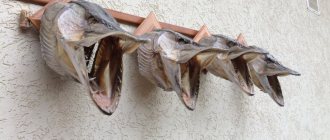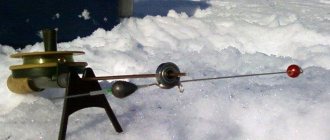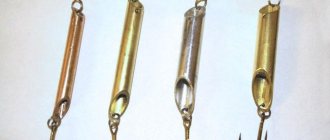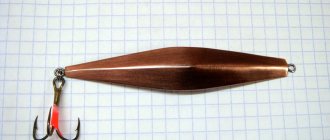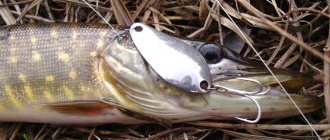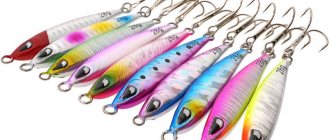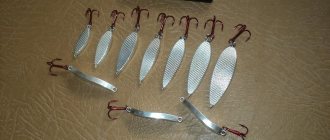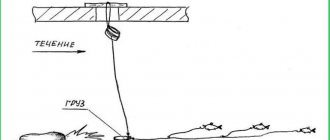With the right approach, fishing for pike perch in winter can be more successful than in summer. This is also facilitated by its commitment to sedentism - it rarely changes habitats at different times of the year. Undoubtedly, fishing for pike perch in winter will be successful if you find out all the characteristics of the fish’s behavior, study the reservoir and properly prepare the gear. And then fishing will bring not only a lot of pleasure, but also serious catch in the form of large and tasty fish.
Tackle for catching pike perch in winter
Pike perch is a fairly large fish, and it is also a predator, which means it is strong, agile, and capable of providing significant resistance. Therefore, with any fishing method, the gear must be of high quality and durable.
- Rod. Long - from 0.4 to 1 meter, very strong, tough. The presence of a nod will help you play the bait better when fishing with a spoon , balancer or jig.
- Coil. There are no special requirements, the main thing is strong, with a good supply of fishing line.
- Fishing line. A thin line makes the tackle more sensitive, but it can only be used on small pike perch. If there is a possibility of a large fish biting, then you should not use a fishing line thinner than 0.25 mm. The optimal thickness of monofilament is 0.3-0.15 mm. You can take a thinner braid - 0.15-0.2 mm (0.18 mm on average), but it must be specially designed for winter fishing, that is, have a polymer coating.
- The nod for catching pike perch is made of a spring or a cone-shaped metal plate.
When biting, the pike perch does not immediately grab the bait, but gently touches it. In this regard, the sensitivity of the nod should be high.
Where to look for and catch pike perch in winter
For successful winter fishing for pike perch, it is imperative to study the fishing reservoir, where are the depths or possible currents, inflowing rivers and streams. It is also necessary to have an understanding of pike perch’s favorite habitats, what it likes to eat, and to study the lifestyle of the predator in winter. Fishing for pike perch from ice occurs all winter, but in different reservoirs the best bite occurs in different winter periods, depending on the location and size of the reservoir and many other factors.
It is believed that the best bite for pike perch occurs in winter, on the first ice and at the end with the onset of spring. At the very beginning of the winter period, the fanged fish is still actively hunting, continuing since the fall, and with the arrival of frosts, in the dead of winter, the fish goes into holes at a depth where the water is slightly warmer than in shallow water, there it rarely feeds and is not active. And already with the arrival of early spring, even under the ice, the predator begins to be active in searching for food and emerges from the depths.
In winter, it is better to fish in places with an influx of clean and fresh water, where there are various bottom irregularities, ridges, hills, large stones and sharp changes; fanged predators use them for their ambushes. However, you will have to look for this predator, walk several kilometers and drill dozens of holes. But if you manage to find a site for this fish, then it can stay there for quite a long time, 5-14 days, and then it can leave this place when the weather changes or in search of prey.
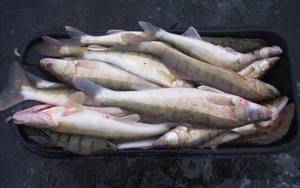
It is interesting that in winter these predatory fish move along the same routes, sometimes, of course, deviating in other directions, but for the most part, without changing their usual underwater paths. Having studied the reservoir and found such trails and sites for fanged fish, with experience it is possible to determine the approximate time of day when the fish goes to certain feeding areas. Experienced fishermen first go around such places with a fishing rod, fishing for points. Depending on the time of day when winter fishing for pike perch, the bite can be in the morning, afternoon, evening and even at night; sometimes it takes well.
When going fishing for pike perch in winter, do not forget about the weather conditions. The predator is sensitive to pressure changes and weather changes. It is believed that the best bite of fanged fish occurs in good sunny weather with growing and moderately high atmospheric pressure. At very high pressure, the predator, like any other fish, does not show activity and becomes overwhelmed. But there are times when a fish grabs a spoon, balancer or ratlin in a blizzard and wet snow; this predator is not always predictable and has a lot of influence on the bite of pike perch in winter.
Fishing location (where to look)
In deep reservoirs, pike perch can be successfully caught all year round. With the onset of winter, some changes occur in the behavior of the fish, but later the pike perch returns to its usual way of life.
- At the beginning of winter, the predator is in shallow water, where various small fish accumulate en masse. He comes here to hunt, and fishing will be successful for 2-3 weeks, in small reservoirs - up to a month. The bite can continue throughout the day.
- In the middle of winter, with the onset of severe frosts, the fish becomes more lethargic and goes deeper into places rich in oxygen. In shallow bodies of water it may go into torpor and stop feeding. The best time for fishing is from evening to early morning throughout the night.
- The end of winter is marked by an increase in the activity of the predator; it begins to feed well and moves after the fry. You should look for it at the mouths of rivers flowing into the reservoir, at the tops of the edges. It can peck throughout the day.
In general, the following places can be distinguished:
- edges and depth changes;
- snags;
- pits;
- braids;
- old river beds.
Pike perch is a schooling fish, so to search for a school, you can team up with other fishermen, systematically examining the reservoir.
Peculiarities of feeding behavior of pike perch in winter
Feeding behavior changes greatly with the onset of winter, so the following features must be taken into account:
- Depending on weather conditions in late autumn or early winter, pike perch actively feeds . The main prey is bleak, redfish and other schooling fish, which the predator presses against the first ice for ease of fishing. At this time, he is hungry, so fishing can also be very effective.
- Gradually, cold weather affects the pike perch's body , slowing down its natural metabolic processes, which also affects appetite. The predator no longer requires a significant amount of food, behavior becomes more passive and the bite also decreases.
- The lack of need for a large amount of food leads to the fact that the pike perch stops moving around the reservoir, so you should look for places where it permanently stops.
- Pike perch is highly dependent on weather conditions ; for this reason, it may lose its appetite during sudden changes in atmospheric pressure, during severe snowstorms or a premature thaw.
- In the first half of winter, pike perch bite best on clear frosty days , but the picture completely changes by the end of January or beginning of February. The behavior of the predator becomes more aggressive, it experiences hunger more often and goes out hunting.
Groundbait and bait
There is no special bait for pike perch. The only thing you can try is to lure the fry to the fishing point using small bait of plant origin, which will create a nutrient cloud in the water.
When fishing for pike perch, baits include various small fish – ruff, perch, bleak, roach, as well as small pieces of fish meat.
The baits are as follows:
- spinners;
- jigs;
- balancers;
- silicone baits.
Catching pike perch in winter will be more successful if you additionally attach small pieces of fish to the hooks of jigs and spinners.
Application of balancers
Comparing modern fishing with the past century, it is easy to notice an increase in the variety of baits for catching aquatic predators. Previously, fishermen used conventional fishing with a vertical spoon, but today, on the ice surface, you can meet hunters with the most unusual devices.
It is especially worth noting catching pike perch in winter using a balance beam. This bait is so successful because the pike perch gradually gets used to the usual methods of catching it. Many experts suggest that fish that have reached a great age and have seen many inedible “pieces of iron” in their life avoid traditional baits. When hunting in packs, seeing how his relatives disappear one after another after being hooked, the instincts of an adult pike perch are triggered.
The balancer's behavior in water resembles a small fish from the outside. Its size should be approximately ten centimeters. Even small fish can catch such a large bait. Remember that the power of the current affects the weight of the hook with bait. In quiet places it is worth using a balancer weighing fifteen grams.
The technology for catching fish on a balance beam is as follows:
- first, we lower it to the bottom;
- then we raise it a little and smoothly wave the fishing rod;
- if the bottom is clogged, you should tap on it in order to raise muddy fountains;
- you shouldn’t make the balancer turn the “eights”, this behavior scares away predators;
- If we still don’t see a bite, we choose a different position.
Recommended reading: How to choose a tent for winter fishing
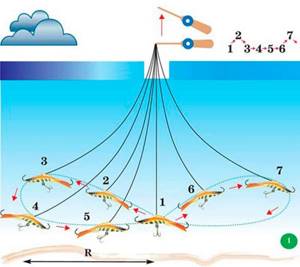
Popular fishing methods
As with other fish, many fishing methods have long been developed and successfully tested for pike perch - all that remains is to choose the most suitable one.
Catching pike perch with sprat
A very simple and effective way to catch pike perch in winter is to use regular (not salted!) sprat bought in a store. The following gear will be required:
- A durable and strong fishing rod with a flexible nod. Length – from 50 cm. The nod must be made of a spring or a metal strip.
- Powerful metal inertial coil.
- Monofilament fishing line 0.30-0.35 mm in diameter. Braid with a thickness of 0.18 mm or more, intended for winter fishing (with a polymer coating), is also suitable.
- Jig head, spoon, jig or treble hook with a bead or eye.
- Sinker.
According to many anglers, using a tee brings very good results, so there is no point in buying jigs and spoons when catching pike perch with sprat.
Fishing tactics:
- The equipment looks like this: a sinker is attached to the end of the fishing line, and a short leash (5-7 cm) is tied above it from the same fishing line to which the tee is attached.
- A sprat is placed on the tee - lengthwise or crosswise. They say that it is better across.
- The bait sinks to the bottom.
There are three types of play with this tackle:
- the bait is motionless, waiting for a bite;
- The bait is thrown up 20 cm with a sharp movement and released. Pause between jerks – 1-1.5 minutes;
- the bait is in constant motion - this is typical when using a jig or spoon instead of a tee.
The size of the sprat should be up to 5 cm, otherwise the pike perch may simply bite off part of the bait without reaching the hook.

Lure fishing
One of the most popular methods of catching pike perch remains lure fishing. It is important to note that this predator can be caught with equal success in summer and winter.
Tackle for catching pike perch in winter with a spinner:
- A powerful rod with increased durability to pierce the fish's jaw when hooking. Length - 35-40 cm. There is a fishing rod of a special design, in which the reel is located at the very edge of the handle, and an additional passage ring is inserted between it and the hand. This allows you to better feel the bite by pressing the line with your finger.
- A simple lightweight reel.
- Monofilament fishing line 0.25-0.4 mm in diameter.
Spoon:
- shape – narrow and elongated. Length – 5-12 cm, width – 8-15 mm.
- material - copper, brass, cupronickel, as well as a combination of metals. Lead soldering is often present.
- color – silver, red, yellow, white. Color combinations using phosphorescent coatings performed very well.
- weight - depends on the reservoir: in still water - 8-10 g, in flowing water - from 20 to 60 g.
The fishing technique involves playing with a spinner in the bottom layers. The spoon is lowered to the bottom, then thrown 30-40 cm and released. After this, a 10-15 second pause is made. Important: the play of the spinner must be uniform and constant.
Pike perch behave quite cautiously in winter, so you should make 15-20 spinner cycles before moving to another hole.
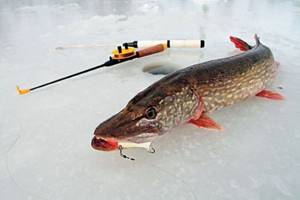
Fishing on a balance beam
Catching pike perch in winter with a balance beam is often much more successful than with a spoon. The balancer is a metal bait that closely resembles a small fish. It is tied to the fishing line by the “back”, so it is positioned horizontally in the water, which only enhances the resemblance to a fry. Hooks are attached to the ends of the bait, and there may also be a treble hook at the bottom.
The length of the balancer ranges from 8 to 12 cm, the color is silver, or as close as possible to the color of the fish that the striped predator feeds on.
The gear used is the same as for lure fishing.
Fishing technique:
- The balancer sinks to the bottom.
- The bait rises 10 cm, followed by a sharp swing that raises the balancer 40 cm above the ground.
- The rod returns to its original position, and the balancer calmly sinks to the bottom. Its movement in the water is very similar to the movement of a real fish, so at the moment of extinction the bite occurs.
- The pause between swings is 15-20 seconds.
- If the bottom is muddy, then you can periodically knock the bait on the ground - a raised muddy cloud will attract a predator.
Pike perch takes well to the balance beam during periods of activity. At very low temperatures, sluggish fish are unlikely to be interested in even the slow action of the bait, so it’s worth choosing other fishing methods.
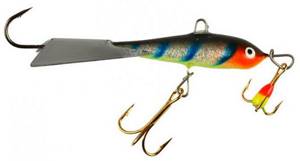
Fishing with ratlins
Ratlin looks like a wobbler, only without a blade. Made in the shape of a fish, flattened shape. A distinctive feature is that the ratlin, unlike other baits, remains at the same depth when moving smoothly with the reel. Ratlin also has a built-in bell or balls, which attract pike perch with their noise.
Peculiarities:
- Weight – 8-15 g, when fishing at great depths – 20 grams. This mass is achieved by a lead plate.
- The color is varied and is tested experimentally during fishing.
- Size - on average 5-7 cm, if the fish is not large, then it can be smaller.
- Sound – in winter it is better to use ratlins with balls, or completely silent ones. A bell can scare away a predator.
Fishing with ratlins in winter involves smooth vertical fishing. The bait is attached to the back and has hooks in the back and bottom. Many people advise removing the rear hook to avoid snagging.
Most of the baits are designed for fishing at depths of up to 7 meters, so they are light in weight. If you fish for pike perch in winter at great depths, you will have to look for ratlins from certain companies made in China and Japan.

Fishing with a jig
Pike perch is a fairly large fish, so the size of the jig can reach up to 20 mm. More often, baits measuring 10-15 mm are used.
The most catchy ones:
- crap;
- simple drop with one hook.
You can use pieces of fish or bloodworms as bait.
When fishing with a jig, you should make slow, smooth movements with the bait with slight swaying. There are different options for fishing techniques:
- The jig sinks to the bottom and several taps are made on the ground. Then a pause of a few seconds and tapping again. The cloud of silt formed by the movements of the bait looks like it is raised by fry, which attracts a predator. The bite follows at the moment of pause.
- Suitable for fishing in currents. While oscillating, the jig is slowly raised by 30-40 cm and the line is loosened. The bait should go with the flow. They lower to the bottom with short pauses and slight fluctuations. Dragging the jig along the bottom will also be effective.
When using a jig, you need to paint it with phosphor paint - this will attract the attention of the fish more.

For live bait
Winter fishing with live bait is no less effective than summer fishing. The following types of fish are used as live bait for pike perch:
- dace;
- crucian carp;
- ruff;
- perch;
- bleak;
- roach.
Tackle for catching pike perch in winter with live bait:
- The fishing rod is an ordinary winter fishing rod, only with increased strength and rigidity. Length – about 0.5 meters.
- The reel is durable with a large supply of fishing line, since a large specimen is capable of dragging hooks with bait to a considerable depth.
- The fishing line is thick monofilament (0.3-0.45 mm).
You need to place the live bait on the hook under the dorsal fin so that the sting comes out on the opposite side. In this case, the fish will occupy a natural position in the water and remain viable for a long time. It is not recommended to stick it behind the mouth, piercing both lips.

Fishing with silicone
Silicone baits such as twister and vibrotail have a number of advantages:
- When fishing in snags, there are fewer snags.
- They do not go far beyond the hole, making it easier to fish out.
- Walleye will hold onto soft bait longer, giving them more time to strike.
The principle of fishing is the same as when using spinners and balancers. You can add short twitches of the bait above the ground - active movements attract pike perch better in the first weeks of winter.
It is worth noting that fishing for pike perch in winter using silicone baits is poorly developed and many fishermen do not use this method.
You need to catch pike perch quickly, without loosening the tension of the fishing line.

Rigging a winter fishing rod for pike perch
When fishing for walleye, you will need to make several attempts in different places. It's hard to know in advance where you'll be lucky. To do this, the rod is carried in one hand, and the line is carried between outstretched arms. Then they are carefully lowered into the new hole.
This method of transfer allows you to clearly see the difference in depth between both holes. As we know, for a good catch you need to try several holes. It is usually recommended that before trying the next option, you need to carry out at least twenty cycles of playing the bait (one cycle - a slight upward jerk and a pause).
Fishing rod
The winter fishing rod is not as long as the summer one. It consists of a handle and a whip. The total length of the fishing rod does not exceed several tens of centimeters.
The whip of a fishing rod for winter fishing must be stiff enough to firmly hook the hook into the mouth of a pike perch. Its length should be approximately thirty centimeters, excluding the length of the rod handle.s here
Nod
- When fishing for this fish, the nod is usually chosen to be as elastic as possible. This is important so that you can track the bite. Sometimes the fish simply pushes the bait several times before swallowing the hook. If you try to hook a pike perch at this stage, there will be no catch. Therefore, you need to very well feel the tension of the fishing line at any given time.
- One of the options for a winter fishing rod for pike perch is that the reel is placed at the very edge of the handle and fishing rod, and a high ring is placed at the other end of the handle. While fishing, the fisherman lightly presses the line to the rod with his finger and can easily control the bite of the pike perch.
- The nod is important for another reason. It creates a smooth fishing action that helps attract walleye.
fishing line
Usually monofilament line is used. It is capable of absorbing strong jerks of pike perch when fishing. It is also important that it will be less noticeable to the fish. The diameter is usually 0.25 - 0.35.
Leashes, fasteners, carabiners
The use of a leader and similar devices usually reduces fishing efficiency due to their visibility to the fish. The use of a metal leash is justified only when there is a chance of catching a pike.
Fishing tactics
When fishing for pike perch in winter, it is important to find a concentration of fish in the reservoir. To do this, you need to consider the following:
- Study the map of the bottom. On a familiar body of water, you can remember the most catchy places in the summer - pike perch usually follows the same routes throughout the year. If the reservoir is unfamiliar, ask local fishermen, or measure the bottom through the holes.
- After selecting a location, drill enough holes to cover the entire area.
- Fishing in winter in the holes takes turns. In this case, you should fish not only the bottom layers, but also depths at a distance of 1-1.5 meters from the bottom.
Large individuals keep to themselves, while small ones live in small flocks. Therefore, when biting a small pike perch, you should not move to another hole - the likelihood that he is not alone is very high.
How to catch pike perch using a balance beam
The balancer is a relatively new type of bait, and today there are not many winter fishermen who already have extensive experience in fishing using balancers.

Modern fishing techniques with balance beams, as well as various new models of them, appeared somewhere at the beginning of this century. But learning the wisdom of this type of ice fishing will not be difficult even for a beginner. When a balancer is used, bait is put on it: a small piece of fish.
The peculiarity of pike perch is that it usually does not pursue its prey. Therefore, when using a balancer, the spoon is played, but not shaken, taking short pauses between movements. So, for example, having lowered the spoon all the way to the ground, you need to lift it 20 cm, then extend it another 50 cm and stop for a short period of time. Next, the spoon must again be lowered to the bottom and a longer pause, approximately equal to 15...20 seconds, must be maintained so that the vibrations of the spoon are completely damped.
If after such a series the pike perch does not bite, then you can try to lift a little mud from the bottom by knocking on the ground. This technique often leads to a bite.
In winter, pike perch’s bites, although sharp, are weaker than in summer, and he himself behaves more calmly and offers less resistance when he is pulled out. Therefore, the fishing rod must have high sensitivity, since the pike perch even takes the bait very carefully. And when you feel a bite, you need to hook sharply so that the hook can pierce the upper lip of the fish. Otherwise, when she approaches the hole, she may release the bait and swim away. The bite of the pike perch is sharp, because by inertia it follows the flock, holding the bait in its mouth, or it wants to go down with the prey.
Tips from experienced fishermen for catching pike perch in winter, which will increase the amount of catch:
- Weak and too soft tackle will not allow it to penetrate the strong mouth of the pike perch, which will lead to the prey falling off the hook.
- When catching pike perch, you should stock up on a hook - this will make it easier to pull the predator out of the hole.
- When fishing with live bait, it is better to drop a couple of meters of fishing line, giving the predator the opportunity to swallow the bait with hooks deeper.
- When fishing from ice, you need to avoid stomping and other noise - pike perch, which are cautious and not too active due to the cold, will be afraid to approach the fishing spot.
- When drilling holes, you should start from a shallow place, gradually going deeper.
- When using long leashes, the sensitivity of the tackle decreases, and the predator may have time to spit out the hook before hooking.
- You can tie several leashes with hooks, but this does not always increase the catchability of the gear, and extra hooks only cling to the ice, creating a lot of inconvenience.
- During periods of severe frost, the tactic of fishing with a spoon consists of short sharp tosses and shaking of the bait.
Catching pike perch in winter is unlikely to leave anyone indifferent. Any angler enjoys competing with strong and agile fish, showing off his skills and showing off his trophy. In addition, pike perch differs not only in size, but also in its rather tasty meat. Therefore, no professional will disdain catching this predator, and an amateur fisherman will receive a great experience and a lot of positive emotions from such fishing.
A few words about the technique of catching pike perch with a spoon
In winter, pike perch rarely move and do not require much food due to their reduced metabolism. A good way to catch such passive fish is to activate the bite through annoying manipulations.
We adhere to the following action plan:
- first you need to lower the hook to the bottom;
- with a smooth movement you need to raise it forty centimeters, and after a few seconds quickly drop it back;
- the hook falls down and flutters five centimeters from the bottom;
- Passive fish mistake this bait for live fish.
The main thing here is to take a five-second pause before lowering the hook to the bottom, because pike perch do not spend all their time in the bottom layer of water. And do not make sudden movements, otherwise you will scare away the fish.
General principles of vertical lure fishing
Whatever fish you catch using this method, such as vertical trolling, the general recommendations will be the same:
- A competent choice of gear (fishing rod, fishing line, spoon, etc.).
- Search for a promising fish location point.
- Selection of effective bait.
- Correctly chosen fishing tactics and use of bait (it is important not only to choose bait, but also to use it correctly).
With this approach, when all the above points are met, you will not only be happy with your catch, but also get tangible pleasure from the fishing process itself, learn how to hunt pike perch, and get a powerful dose of fishing experience - not a single fanged predator will leave you.

